Measurement of Sun Noise

Here's the summary for those who don't want to read the article:
For the best consistency between stations and between readings from the same station at different times, Sun noise (Y-factor) readings should be made my subtracting the noise power with the antenna pointing at the coldest part of the sky from the noise power with the antenna pointed at the sun.
#1 tip - Turn off the AGC
What is Sun Noise
The sun is a large, very hot, thermonuclear furnace that radiates energy across the electromagnetic spectrum from X-rays, through visible light and out to microwaves. It radiates at all wavelengths and the radiation is (generally speaking) unpolarized. So at any wavelength (say 23cm), you see the same amount of power radiated with vertical polatization, horizontal polarization, Right hand circular polarization, Left hand circular polatization or any other (slant, elliptical) polarization. While the actual power output isn't constant, it's monitored and measured by many measurements in many countries and those measurements are made public. So at any time the sun makes a good RF emitting source of known power and so can be used as a reference for determining receiving system perforce.
In the rest of this article the term "Sun Noise" is used to describe a measurement of the ratio of the power received when an antenna is pointing at the sun, to the power received with the antenna pointing at a cold part of the sky.
For more about Sun noise, see the page here on Understanding Sun Noise.
Why measure sun noise?
Sun noise can be used to establish a relative "figure of merit" for a receiving system. Basically, the more sun noise you see, the more sensitive your receiving system is and the weaker the signals you will be able to detect. If you optimize everything (dish, feed, preamp, cables, connectors etc.) to give you the highest sun noise reading, then you have optimized your receiving system. Note that sun noise is NOT a measure of the strength of your transmitted signal. For best Rx performance (maximum sun noise, best G/T) the illumination of the edge of a dish is probably going to be 14-15dB less than at the center. This reduces spill-over and so reduced pickup of unwanted ground noise. For maximum transmitted power (ERP) the optimum illumination at the edge of a dish is about 10dB less than at the center. The bottom line is that adjusting a dish and feed system for maximizing sun noise will allow you to hear the weakest signals, but will not give you the loudest possible Tx signal (highest ERP).
So if you are a high power station who wants to work weak stations, maximizing sun noise is probably the best strategy. On the other hand if you are a low power station who wants to work high power stations, the best strategy might be to maximize your Tx gain.
What exactly are you measuring?
Measuring the amount of RF noise you see from the sun is a fairly easy, reasonably accurate, reasonably reproducible and quite convenient method of measuring your receive system performance. The qualifiers are in there because the numbers you see depend on a number of factors. It depends how active the sun is (RF power output fluctuates). It depends on the gain of your antenna. It depends on the noise figure of your Rx system. It also depends on how much ground (or other) noise your antenna sees (including contributions from side lobes).
The "normal" measurement technique is called the "Y-factor" method. Basically you point your antenna at the sun (ideally when it's at high elevation) and measure the indicated noise power in dB. Then you point the antenna away from the sun (ideally at a cold part of the sky at high elevation) and measure the indicated noise power in dB. The difference in these readings is the "Y-factor" or the "Sun Noise". Note that It a measure of (Signal+Noise)/Noise, not Signal/Noise.
How do you measure it?
You need a linear response system. What you are measuring must hace a linear response to the received RF power, So #1 TURN OFF ANY AGC in your system
Well, if you are a professional, taking scientific readings of sun noise, you do it this way https://agupubs.onlinelibrary.wiley.com/doi/full/10.1002/swe.20064
For the rest of us, one way to directly measure RF (or IF) power with the use of RF amplifiers, filters and RF power meters or specially constructed wideband receivers, but those methods involve equipment few people available. It's easier to do with software and your existing receiver. You can make the measurement using the audio output of the receiver (or sound card), though that makes the bandwidth only ~2.5kHz for most receivers. Wider bandwidths are better because averaging the noise over a wider bandwith lowers measurment noise.
The easiest way to measure audio power was the "measurement" mode of WSJT10. I will cover that new, but the new WSJT-X 2.6.0 has a better measure mode and will will cover that after WSJT 10. When configured for normal EME operation, in "measurement" mode WSJT10 measures the average noise power in the audio bandwidth once per second and displays a number (in dB) on the screen. There's no control over integration time or measurement bandwidth, but it's a very simple way to measure sun noise requiring only the equipment you normally use for EME. An example is shown below. The first number is time (seconds since you started measurement) and the second number is the audio power to the nearest 0.1dB averaged over a 1 second period. AGC must be OFF of course for any audio power based sun noise measurement.
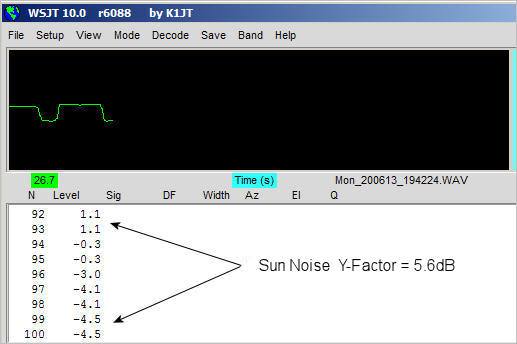
The more recent WSJT-X v2.6.0 (and anything after that) has a much improved echo and noise measurement mode, though it does lack the real time plotting capability of WSJT 10. When measuring noise power WSJT-X 2.6.0 integrates the noise over a 2.3 second period and updates the reading, which are presented with 0.01dB resolution every 3 seconds. An example is shown below:
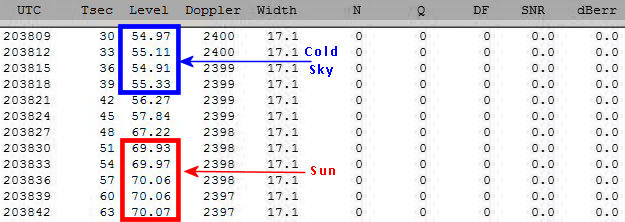
This shows cold sky at about 55dB and the sun at about 70dB, giving sun noise at about 15dB.
A more accurate method with a longer (user delectable) integration time and higher resolution is to use SpectraVue (https://www.moetronix.com/spectravue.htm) to look at the audio output as shown in the figure below:
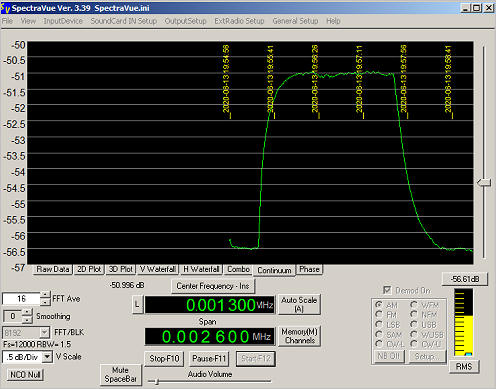
This plot shows a sun-noise Y-factor of around 5.5dB. Data can be stored in a file for later analysis.
The wider the bandwidth over which the noise is measured the better. With a wide bandwidth there is less "noise on the noise", i.e. the more stable the reading will be and the higher the S/N ratio will be. This means either measuring over wideband audio or measuring RF noise over an even wider bandwidth (several MHz). Some sound cards (or devices which emulate then) can sample at rates up to 192kHz. SpectraVue can also be used to look at the output from an SDR over a wider audio bandwidth. Below is the trace from SpectraVue looking that the 90kHz wide output from a FunCube pro plus SDR.
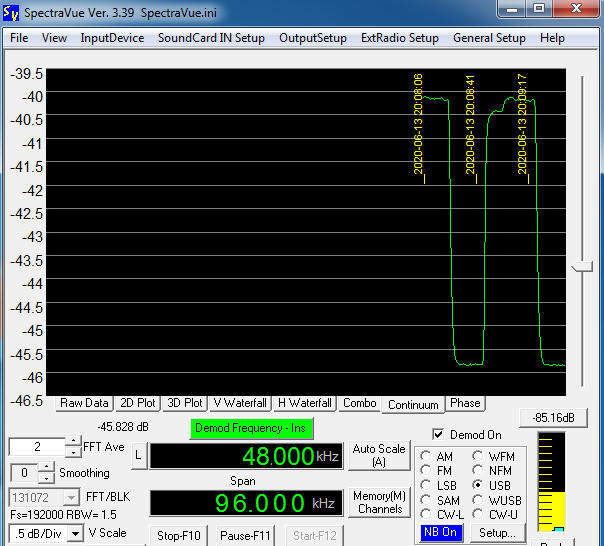
Here we are looking at a sun-noise Y-factor of around 5.7dB
Don't worry about the absolute values of the numbers because we're only interested in difference between them. If the sun measures -43 and the sky measures -56 by one scheme and the sun measures -3 and the sky measures -16 by a second scheme, they are both indicating sun noise (Y-factor) of 13dB. The absolute numbers may depend on AF and RF gain settings, but the difference between then should not (Audio measurements MUST be made with AGC turned off). The AF and RF stages are assumed to be liner in response. That's normally a good assumption.
If you aren't sure about the linearity of your noise measuring system there's a second method, provided you have a variable attenuator which is calibrated at the frequency you are using it at. Typically this would be your IF frequency, e.g. 144 Mhz if using a 1296/144 transverter. With this method you set the attenuator at 0.0dB and point the antenna at the quietest part of the sky you can find. Note down the indicated noise power. Then point the antenna at the sun. The noise power will rise. Increase the attenuator until the noise drops back down to the reading you saw on cold sky. The attenuator value then gives you the Y-factor (sun noise). If the attenuator reads 10.35dB, your y-factor (sun noise) is 10.35dB.
Here's an example of a measurement made using SpectraVue. It shows a Y-factor of 11.6dB. A Funcube Pro Plus was used in conjunction with SpectraVue. The measurement bandwidth was 90kHz.
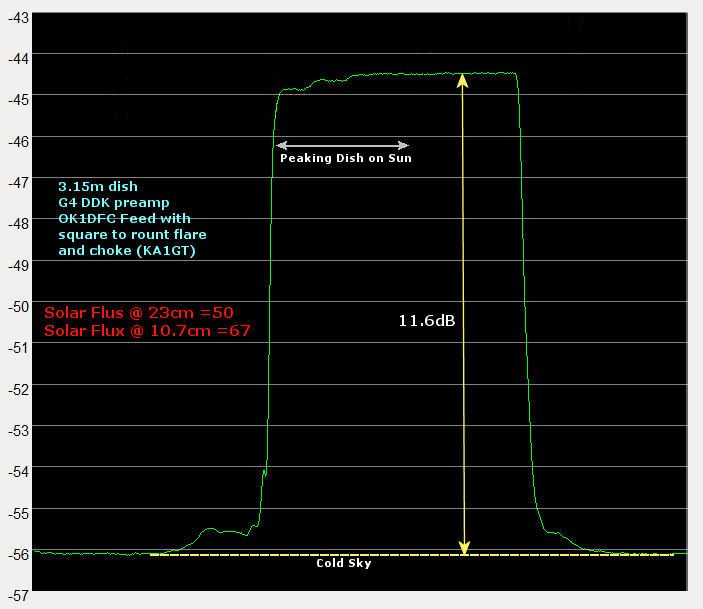
Linearity
The techniques described here for measuring sun noise depend on the whole system, from RF through IF to audio being liner, with no stage showing compression and no AGC being applied. A 10dB change in noise power from the sun must give a 10DB change in IF power and/or audio power. So how do you check that is, in fact, the case.
One way to do this is by using a step attenuator in the IF. For example below is the result of a 10Ghz sun noise measurement. The IF in this case was 432 MHz. So a step attenuator with know good accuracy at 432 MHz was places in the IF chain (i.e. between the downconverter and the rig). The plot below shows what happened to the audio signal level as the attenuator value was changed. SpectraVue was used to measure noise, but you could use the echo mode in WSJTX, write down the numbers and plot them.
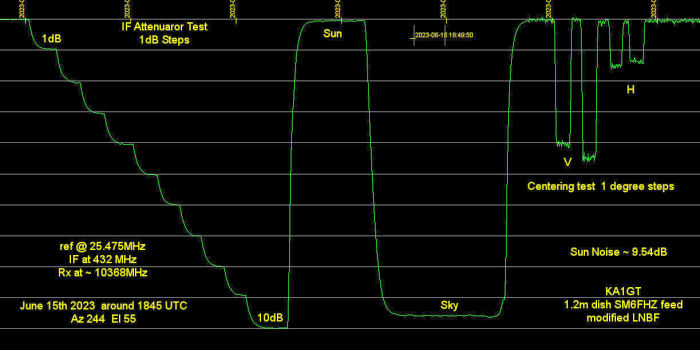
On the left of the trace you can see the effect of increasing the IF chain attenuation in 1dB steps. As you can see, each 1dB step change in attenuation results in a 1dB change in noise level as measured by this technique. Therefore the measuring system is linear (assuming RF section and IF amplifier are linear, which is usually a good assumption). The 10.7cm solar flux was ~157 at the time of measurement and sun noise measures ~9.5dB.
If the system isn't linear, then you have to investigate why. Is AGC operation on some stage? Do you have a stage with so much gain that it's going into compression? This test would not show non-linearity in the LNA and downconverter which sit ahead of the IF stage, but that is rarely the case. If there is enough gain between the LNA first stage and the downconverter, you can put the attenuator between the two and moderate levels of attenuation (< 10dB) should not affect the system noise figure, so you should get the same reading as with the attenuator in the IF. The danger here is that if the LNA doesn't have enough gain, and/or the downconverter has a very high noise figure, attenuation between the LNA and downconverter can increase the system noise figure and so affect the measured system linearity.
Some theory and some numbers
Note, this analysis is applicable for 1296Mhz (and up), where the cold sky temperature is vet cold (a few K). On a band like 144Mhz, sky temperatures can be high and terrestrial noise may be high, so the analysis would be somewhat different.
I have seen it suggested that you should measure sun noise by comparing the noise power with the antennas pointing at the sun compared with the noise power with the antenna moved off the sun by a couple of antenna beamwidths. The idea behind this (I assume) is to try to estimate the sky noise which would be present if the sun were not there, i.e. the sky noise behind the sun. This is NOT a good way to measure sun noise as the analysis below indicates. Here's the reason why.
Here's a screen-shot of a spread-sheet which looks at the numbers involved in a typical measurement.
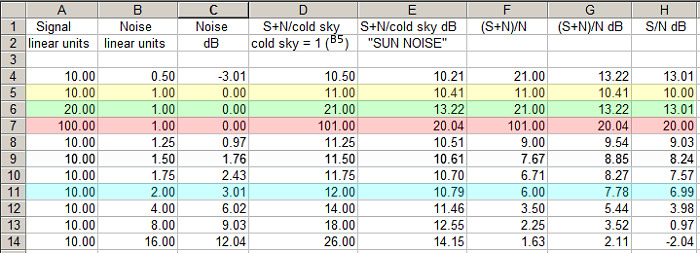
- A is the signal strength. The units don't matter but let's say they are femtowatts (10^-15W). The is the amount of RF power from the sun that is captured by your antenna and arrives at the input of your preamp.
- B is the noise power of your receiving system in the same units as A. It consists of the amount of RF power from the sky that is captured by the antenna (including side lobes), plus any noise generated within the preamp (i.e. the preamp Noise Figure).
- C is the noise expressed in dB relative to a reference level of 1 which we will define is the coldest sky (B3)
- D is the Signal to noise ratio for linear power units (femtowatts)
- E is the same as D but expressed in dB. It's also the Y-FACTOR if you use the cold sky reference noise level
- F is the (signal+noise)/noise ratio for linear power units
- G is the same as F but expressed in dB. This is the Y-FACTOR using the elevated noise level as the noise reference
- H is the actual signal to noise ratio (sun power/noise power) in dB
Row 5 (yellow) represents a "reference" condition in which the noise from the sun is 10 units (femtowatts for example) while the system noise with the antenna pointed to a "cold" part of the sky is 1 unit. The noise from the sun and the system (cold sky) noise will add, so that with the antenna pointing at the sun the system will record 11 units of RF power. This gives a signal plus noise to noise ratio ((S+N)/N or Y-Factor) of 11 (cell 5D) or on a dB scale, 10.41dB (Cell 5G). This is the Y-factor or "sun noise" reading. Rows 6 (green) and 7 (pink) show that as the signal goes up (and the noise stays the same), the Y-factor (column G) gets closer to the actual signal to noise rate (column H). Y-factor is what everyone reports as "sun noise", so in this case "Sun Noise" would be 10.41dB. [Note that while the Y-factor is 10.41dB, the actual signal to noise ratio in this case is 10dB.]. The Y-factor measurement will always tend to overestimate the noise power of the sun at low values reactive to high values.
The numbers in the table above show that if you are measuring sun noise by the Y-factor method - or if two similar stations are comparing sun noise measured made by Y-factor - the value of the cold sky noise readings has a large effect on the Y-factor result. For example, if one station is measuring the sun at low altitude and picking up significant ground noise, they might get the numbers shown in row 11. Measuring their sky noise level with the sun just out of the bean (where the noise is 3dB more than cold sky - cell 11C), they may report a reading of 7.78dB (cell 11G). A second station (shown in row 5) at a different location may see the sun at high altitude and may not pick up much ground noise at all and their sky noise may be that of the cold sky. Their sun noise reading will be 10.4dB as shown in line 3 (Cell 5G). That's a 2.62dB difference. Both systems may have the same preamp with the same NF and the same dish with the same feed, so the hardware of both stations may be exactly the same.
But if both stations use the coldest sky temperature for their noise reference, the difference is much smaller. as can be seen in column E above, the station measuring the sun at low altitude would report a Y-factor of 10.79db, vs. the station measuring the sun at high attitudes number of 10.41dB, only a 0.38dB difference.
So the bottom line here is that, certainly at 1296MHz and higher, you should measure sun noise (Y-factor) with the sun at high altitude (so there's as little additional noise as possible), and you should use the coldest spot in the sky that you can find as the background noise reference. That will provide the best consistency between stations and between readings from the same station at different times with the sun in different positions.
.jpg)